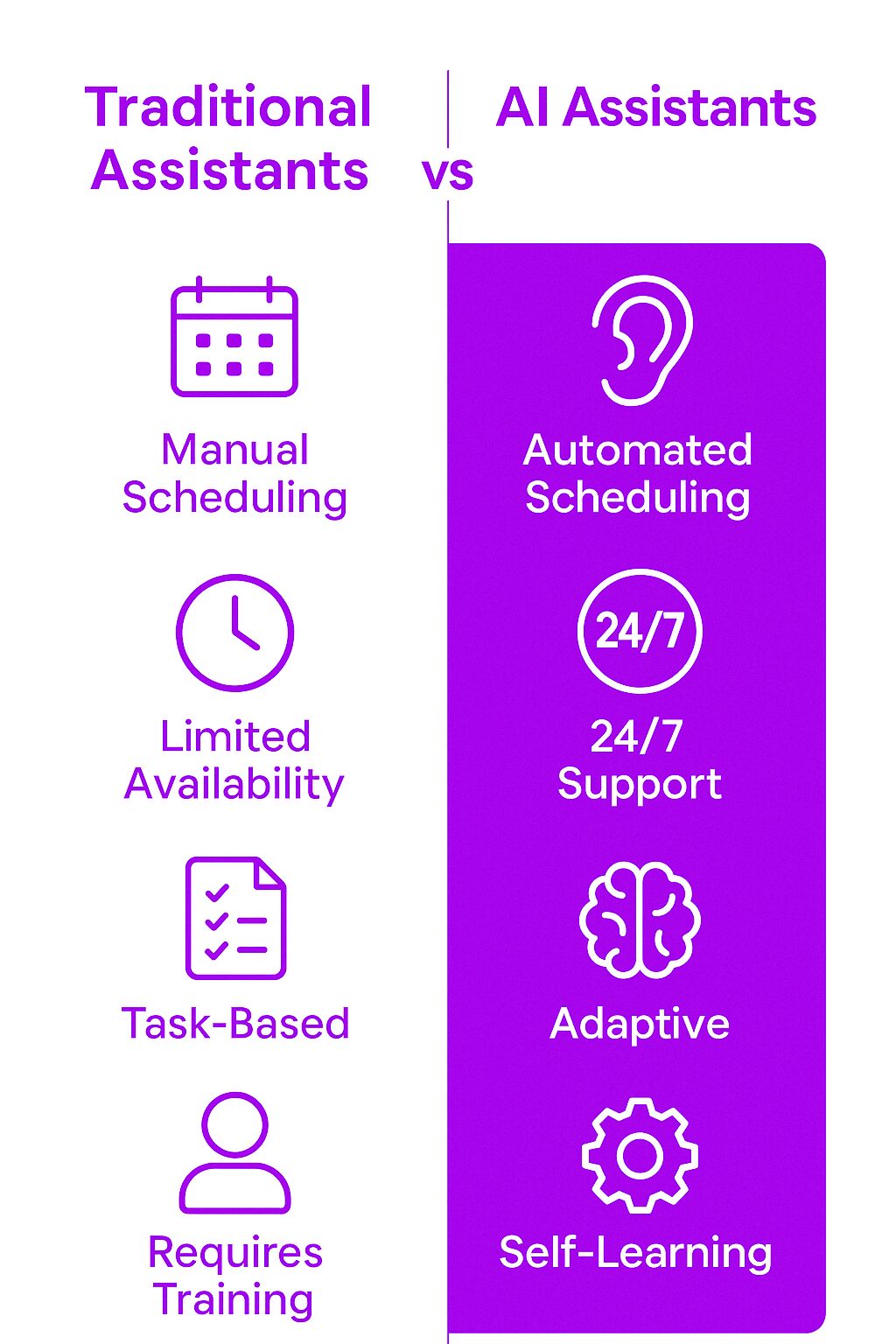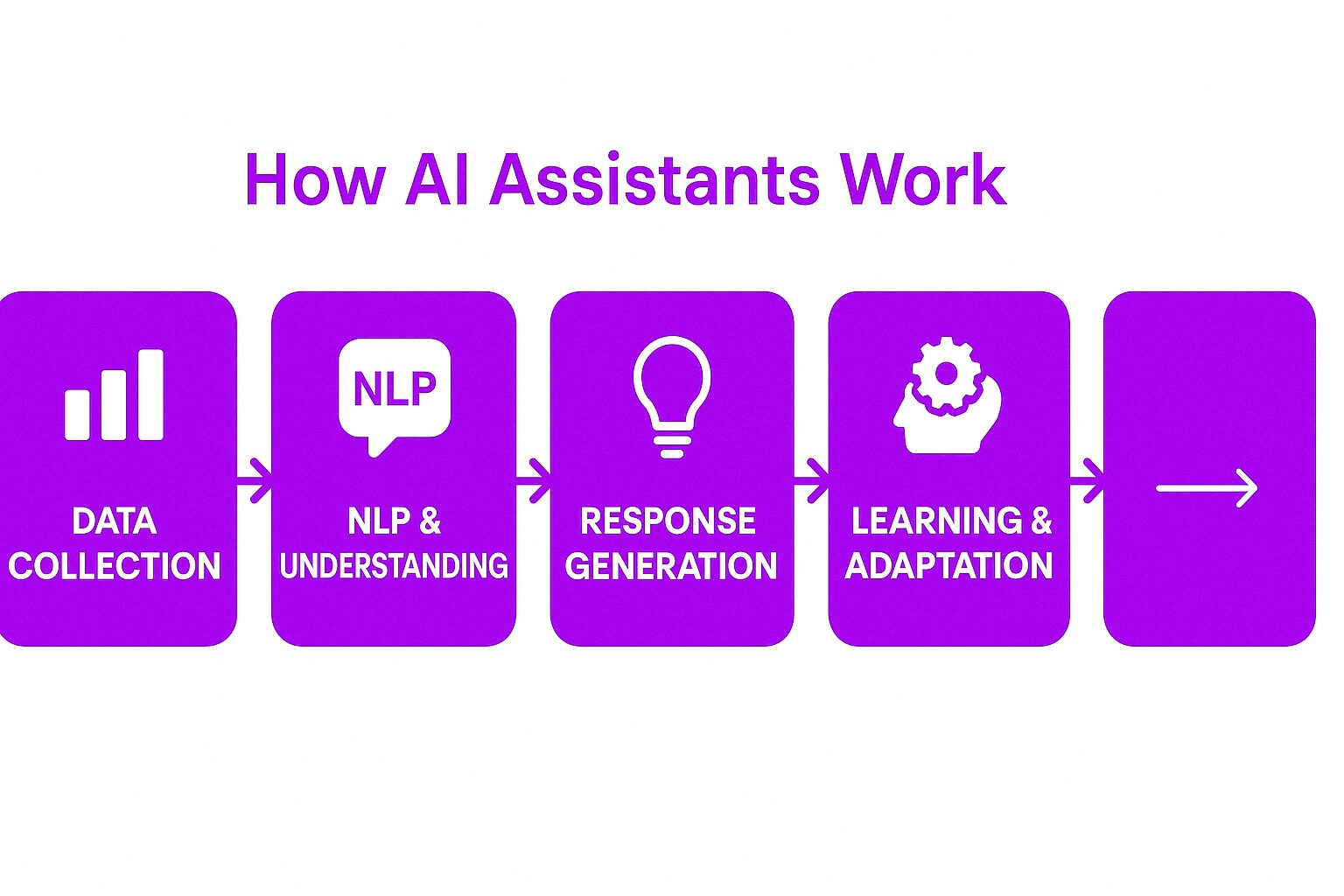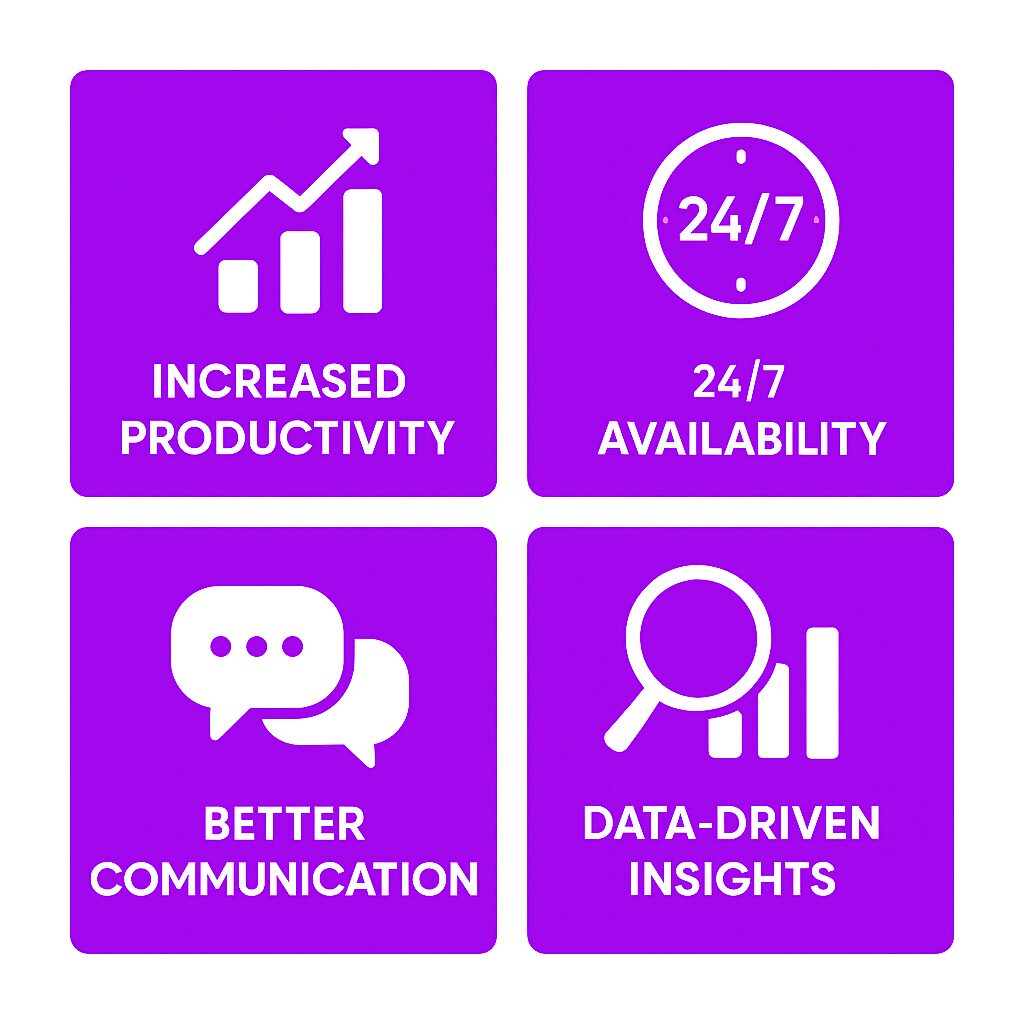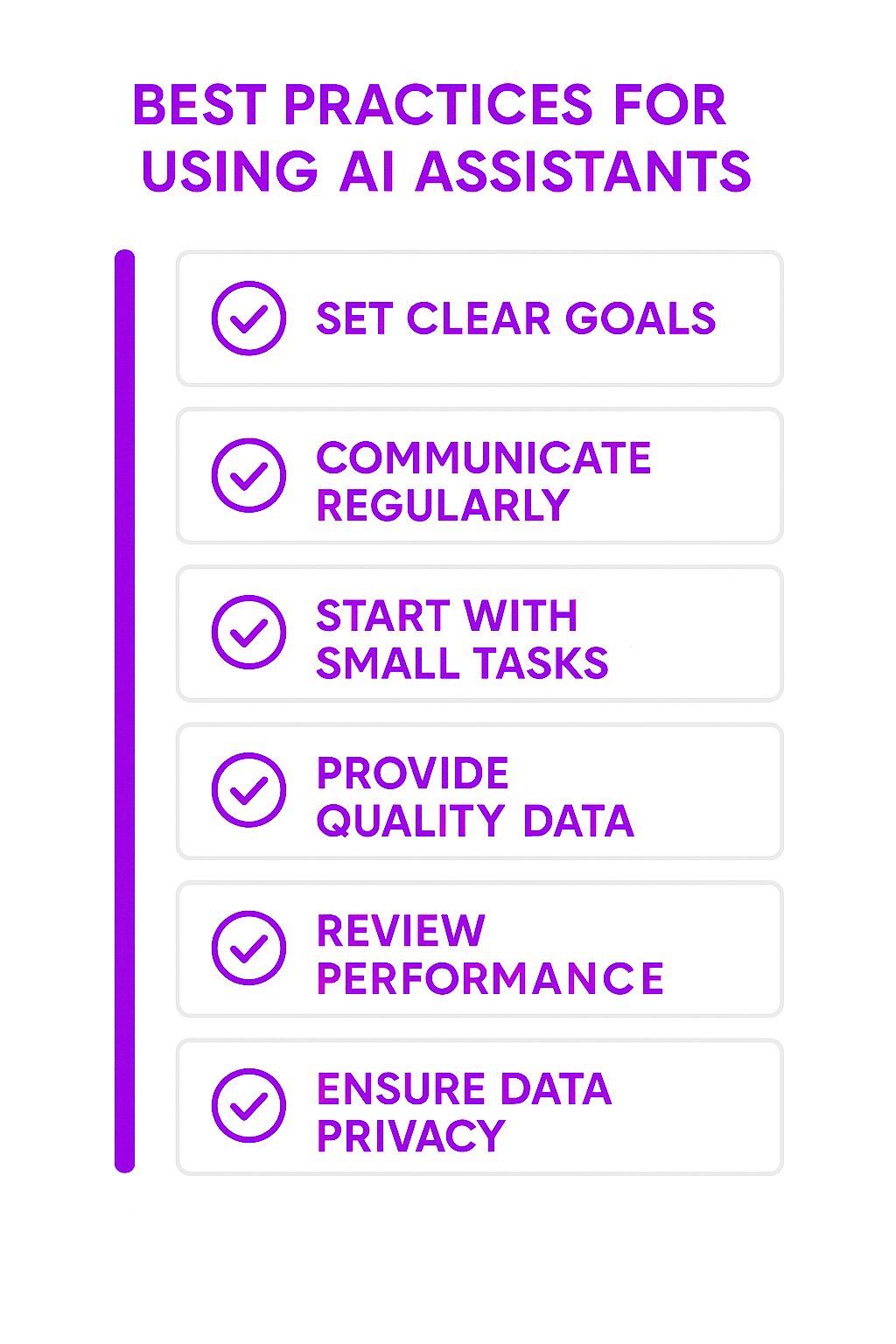What is an AI Assistant?
An AI Assistant is a software program that helps users complete tasks by using artificial intelligence. These assistants can process natural language, learn from interactions, and automate repetitive actions. Unlike traditional digital assistants, AI Assistants go beyond simple voice commands or pre-programmed responses. They adapt to user behavior, provide personalized recommendations, and integrate with multiple business tools.
AI Assistants appear in many forms, from chatbots in customer service to advanced workplace tools that manage emails, meetings, and workflows. Whether they operate through text, voice, or automation, their goal is to simplify tasks and improve productivity.
Definition and Purpose
An AI assistant is a software program that leverages artificial intelligence to provide information and perform specific tasks. The primary purpose of an AI assistant is to simplify users’ routines and enhance their productivity. By automating tasks, offering insights, and completing tasks on behalf of the user, AI assistants make daily activities more manageable and efficient. Whether it’s managing schedules, sending reminders, or providing data-driven recommendations, AI assistants are designed to streamline various aspects of personal and professional life.
How AI Assistants Work
AI Assistants function using a combination of natural language processing (NLP), machine learning, and data analysis. Here’s how they operate:
Data Collection
The assistant gathers information from user input, system interactions, or external data sources. This could be typed messages, voice commands, or historical data from emails, calendars, and documents. External data sources can include platforms like Google Drive, where important information can be accessed and managed effectively.
Processing and Understanding Natural Language
Once data is collected, the assistant uses NLP and machine learning to analyze the input. It breaks down language patterns, understands intent, and determines the best response or action. Generative AI further enhances the assistant’s ability to understand and generate responses by learning from user patterns and automating processes.
Natural Language Processing (NLP)
AI assistants rely heavily on natural language processing (NLP) and large language models to understand and interpret users’ text or speech inputs. NLP enables these assistants to grasp the nuances of human language, including context, intent, and sentiment. This capability allows AI assistants to engage in natural, conversational interactions with users, providing fluent and relevant responses to their queries. By understanding natural language, AI assistants can perform tasks more accurately and efficiently, making them invaluable tools for both personal and professional use.
Response Generation
Based on its understanding, the AI Assistant provides an appropriate response. This can range from answering a question, performing a task, sending a reminder, or automating a workflow. Additionally, AI tools assist with content generation, enhancing productivity by streamlining the process of creating content.
Learning and Adaptation
AI Assistants improve over time by learning from interactions. They analyze user preferences, refine responses, and adapt to specific needs to enhance future performance.
Additionally, AI assistants use insights based on user interactions to improve performance, drawing from unique enterprise data and business objectives to ensure efficiency and data security.
Types of AI Assistants
There are several types of AI assistants, each designed to cater to different needs and environments.
Virtual Assistants
Virtual assistants, such as Siri, Google Assistant, and Alexa, are among the most well-known AI-powered assistants. These virtual assistants can perform a wide range of tasks, from ordering products online and managing calendars to creating travel itineraries and playing music. They are designed to provide conversational and fluent responses to users’ queries, making interactions seamless and intuitive. By integrating with various devices and platforms, virtual assistants help users manage their daily activities with ease and efficiency.
Why AI Assistants Matter
AI Assistants change how people interact with technology. They make work easier by reducing time spent on administrative tasks. They help teams communicate more effectively, automate routine processes, and provide data-driven insights.
For businesses, AI Assistants improve efficiency by handling simple inquiries, managing schedules, and integrating with enterprise tools. They reduce the need for manual data entry and allow employees to focus on strategic work instead of repetitive tasks.
Benefits of AI Assistants
Increased Productivity
By automating repetitive tasks, AI Assistants allow users to focus on more critical work. Whether scheduling meetings, organizing emails, or retrieving information, they reduce the time spent on small but necessary tasks.
24/7 Availability
Unlike human assistants, AI Assistants do not need breaks or sleep. They operate around the clock, answering questions, providing support, and executing tasks at any time.
Better Communication
AI Assistants streamline communication by organizing conversations, summarizing key points, and providing relevant context. They help teams collaborate without the back-and-forth of emails or messages. Additionally, AI assistants streamline communication through messaging apps, allowing users to interact via natural language text or voice messages for seamless task execution.
Data-Driven Insights
AI Assistants analyze data to provide useful insights. They help users make informed decisions by summarizing trends, detecting patterns, and highlighting important information.
Seamless Integration with Business Tools
Many AI Assistants connect with platforms like Slack, Microsoft Teams, Google Workspace, and CRM systems. This allows them to manage information, automate workflows, and provide real-time updates without requiring manual input. Additionally, AI assistants help manage and enhance customer journeys by utilizing technology to keep interactions on track and providing actionable insights for sales teams.
AI Assistant Features
AI assistants come equipped with a variety of features that enable them to complete tasks and provide valuable insights to users. Some of the key features include:
Task Automation
One of the standout features of AI assistants is their ability to automate repetitive and mundane tasks. This includes scheduling meetings, managing personal finances, and generating content. By automating these tasks, AI assistants free up users’ time, allowing them to focus on more critical activities. Additionally, AI assistants can handle data analysis, providing insights and recommendations based on the information they process. This capability not only enhances productivity but also helps users make informed decisions quickly and efficiently.
Challenges of AI Assistants
Privacy and Security Concerns
AI Assistants often handle sensitive data, making security a priority. Businesses must ensure that these tools comply with data protection regulations and implement strong access controls.
Dependency on Data Quality
The effectiveness of an AI Assistant depends on the quality of the data it receives. If data is incomplete or incorrect, the assistant may provide inaccurate results.
Learning Curve for Users
Adopting AI Assistants requires a period of adjustment. Users must learn how to interact with them effectively and understand their capabilities and limitations.
Potential Bias in AI Models
AI Assistants learn from the data they process. If that data contains biases, the assistant’s responses may reflect them. Organizations need to monitor AI outputs to ensure fairness and accuracy.
Limited Handling of Complex Tasks
While AI Assistants can automate many processes, they may struggle with tasks requiring human judgment, creativity, or deep emotional intelligence. However, they can help sales teams win more deals by enhancing workflows and automating data entry, even if they face challenges with complex tasks.
Best Practices for Using AI Assistants
Select the Right AI Assistant for Your Needs
Different AI Assistants specialize in different areas. Some focus on workplace productivity, while others excel in customer service. Define your needs before implementing an AI solution. It is also important to choose a personal AI assistant that offers personalized features to enhance user experience and improve task completion.
Maintain Data Security
Ensure that AI Assistants comply with data privacy laws and implement strong encryption methods. Limit access to sensitive information to prevent unauthorized use.
Train AI Assistants with Quality Data
The more accurate and structured the data, the better the AI Assistant will perform. Regularly update and refine input data to improve results.
Encourage Employee Adoption
Provide training and clear guidelines on how to use AI Assistants effectively. Address concerns and demonstrate the benefits to encourage widespread adoption.
Balance Automation with Human Oversight
AI Assistants should enhance human productivity, not replace critical decision-making. Use them to support workflows, but keep human oversight where necessary.
Related AI Concepts
Conversational AI and Generative AI
AI-powered chatbots and virtual assistants that interact with users via text or voice conversations. Personal AI provides a more tailored and interactive experience, enhancing language understanding and functionality to better meet user needs.
Virtual Agents vs. AI Assistants
Virtual agents are typically customer-facing, handling support inquiries. AI Assistants focus more on workplace productivity and automation.
AI in Customer Support
AI Assistants streamline customer interactions by answering FAQs, troubleshooting issues, and escalating more complex requests to human agents.
AI for Workflow Automation
These tools automate repetitive business processes, reducing manual work and improving efficiency across departments.
AI Assistant Use Cases
Workplace Productivity
AI Assistants like Google Assistant, Microsoft Copilot, and Notion AI help employees manage schedules, automate tasks, and retrieve information quickly.
Customer Service
Companies use AI chatbots to provide instant responses to customer inquiries, reducing wait times and improving service quality.
Sales and Marketing
AI Assistants analyze customer behavior, recommend personalized marketing strategies, and automate follow-up emails. The introduction of a new personal AI assistant for sales and marketing tasks enhances user interactions and overall functionality.
Healthcare
AI-powered assistants support medical professionals by organizing patient records, suggesting treatment plans, and providing diagnostic insights.
Education
AI-powered tutors provide personalized learning experiences, track student progress, and assist with administrative tasks. Additionally, AI assistants can integrate with other messaging apps to assist with educational tasks, enhancing communication and collaboration.
Final Thoughts
AI Assistants have become a valuable tool in both personal and professional settings. They improve productivity, streamline communication, and automate time-consuming tasks. While they come with challenges, careful implementation and human oversight can maximize their benefits. As AI technology continues to advance, AI Assistants will play an even greater role in enhancing work efficiency and decision-making.








